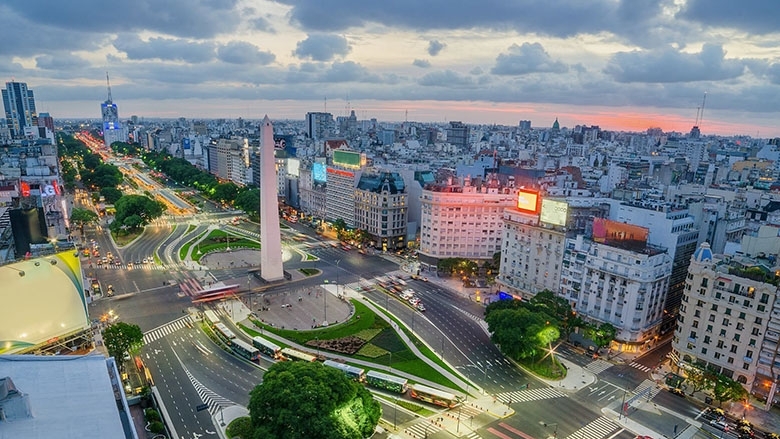We live in an increasingly urbanized world. Every day, hundreds of people move to cities in search of job opportunities, better services, and infrastructure that can withstand natural phenomenon. Latin America and the Caribbean is the second-most urbanized region in the world and, as cities expand, their challenges also increase. Resilience in the face of disasters, better roads and transportation, more inclusion and access to financing are some of these challenges.
This week, more than 30 mayors and city leaders from around the world met in Buenos Aires to talk about the progress they have made and the obstacles they face, and especially to discuss how cities – where the largest share of global GDP is produced – can contribute to the global agenda. We spoke with two experts from the World Bank Group, Ede Ijjasz-Vasquez, Senior Director for the World Bank’s Social, Urban, Rural and Resilience Global Practice, and Gabriel Goldschmidt, director of the International Finance Corporation (IFC) for Latin America and the Caribbean, to discuss their vision for the future of cities, their main challenges and how to address them.
Question (Q): Ede, urbanistic discussions have recently focused on resilience. Could you define urban resilience and give us some examples?
Ede Ijjasz-Vasquez (EIV): While there is no standard definition for urban resilience, most definitions coincide in that it refers to the capacity to manage a wide range of impacts and stresses that can occur in a city. While resilience has traditionally focused on climate change and its impacts – floods, earthquakes, hurricanes, and volcanic eruptions – it is also the ability of an urban system to prepare and adapt itself to technological and socioeconomic changes. The former ranges from a breakdown and interruption of the water or energy system of a city, to a gas leak, a water pollution event or an explosion at an industrial plant. Socioeconomic changes refer to economic crises, demographic changes, terrorism events, strikes or social and political conflicts.
Q: In Latin America, eight of every 10 people live in cities, but many of them – the poorest – settle in the outskirts and lack access to basic services. How can we promote social inclusion and improve their quality of life?
EIV: The poor live in both downtown areas and the outskirts. Many of them live near the downtown areas to access jobs, often in informal settlements where the housing is more “accessible,” but in precarious conditions. These settlements often lack quality infrastructure and services. For cities to be inclusive, it is necessary to improve these informal settlements. For example, with support from the World Bank and the Inter-American Development Bank (IDB), the government of the City of Buenos Aires is working to improve one of its most vulnerable and emblematic neighborhoods, Barrio 31. On the outskirts, where most urban growth is occurring, cities must urgently adopt a planning process with a view to the future so that they can provide infrastructure and services along with well-located housing at prices that are accessible to the low-income population.
Q: With respect to employment, how can cities prepare for future labor market challenges?
EIV: Cities in the developing world will have to accommodate a growing youth population that will continue to migrate from the countryside to the city. At the same time, cities in the developed world will have to prepare now for migrations of youth populations from less developed countries, which will accompany the aging of the countries’ own inhabitants. Migrations of people in search of opportunities, displacement due to conflict and violence, as well as an increased incidence and intensity of natural disasters associated with climate change, will increase the size of cities. At the same time, new technologies present challenges and opportunities for employment. While automation will replace many jobs, it will create new opportunities for others. New technologies have the potential to change the way people travel to work and transform complex markets such as that of real estate. Cities should work together with national governments to develop national urban policies that integrate local sector policies, rethink labor market and job training policies, and use those same technologies to manage cities.
Q: What role should development institutions such as the World Bank play, as well as city mayors, who have an increasingly key role in the future of the urban agenda at the global level?
EIV: Mayors are key players in the development of the global agenda. As cities concentrate the majority of inhabitants, and as they produce the largest share of GDP and greenhouse gas emissions, they are centers where the future of the world’s sustainability will be played out. Even though this is obvious, cities have not been considered enough in the process to establish the global agenda. Local leaders and mayors have very interesting experiences to bring to the table; the expert knowledge they have of urban problems and their proximity to the population they represent make them key actors for developing alternative, creative solutions to the most complex global problems. For this reason, the World Bank, together with other multilateral agencies, is committed to helping cities promote the exchange of knowledge among them and with national leaders. Likewise, the World Bank is well-positioned to help municipal governments take measures to promote investment in projects that improve the population’s quality of life.


